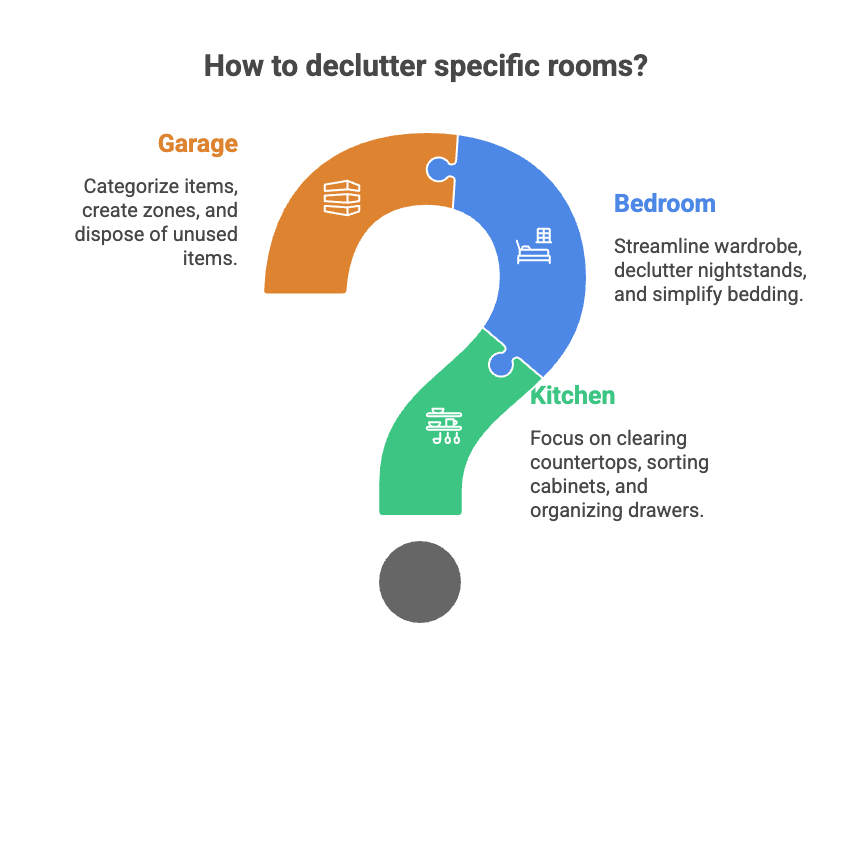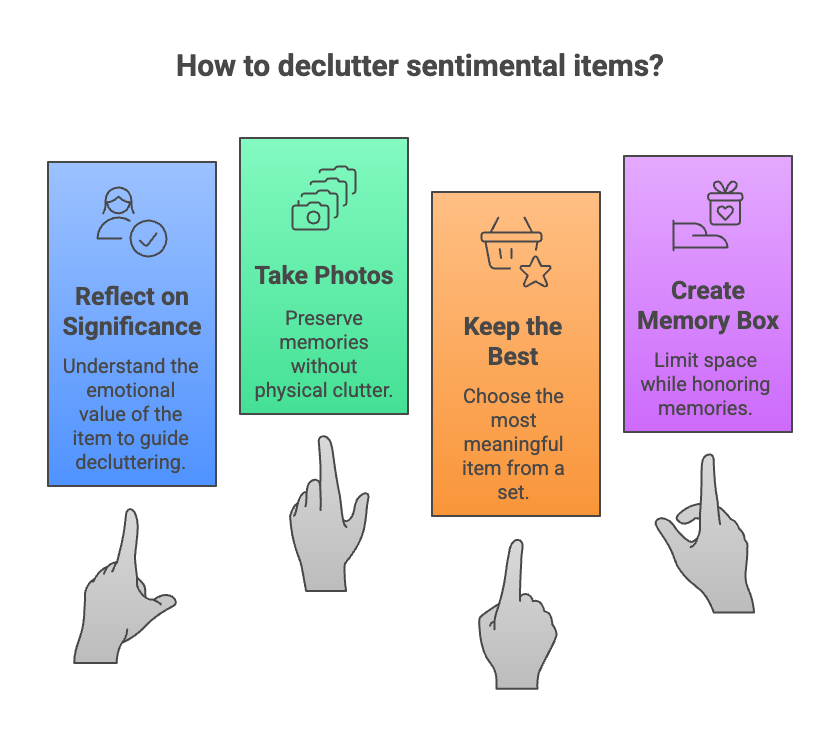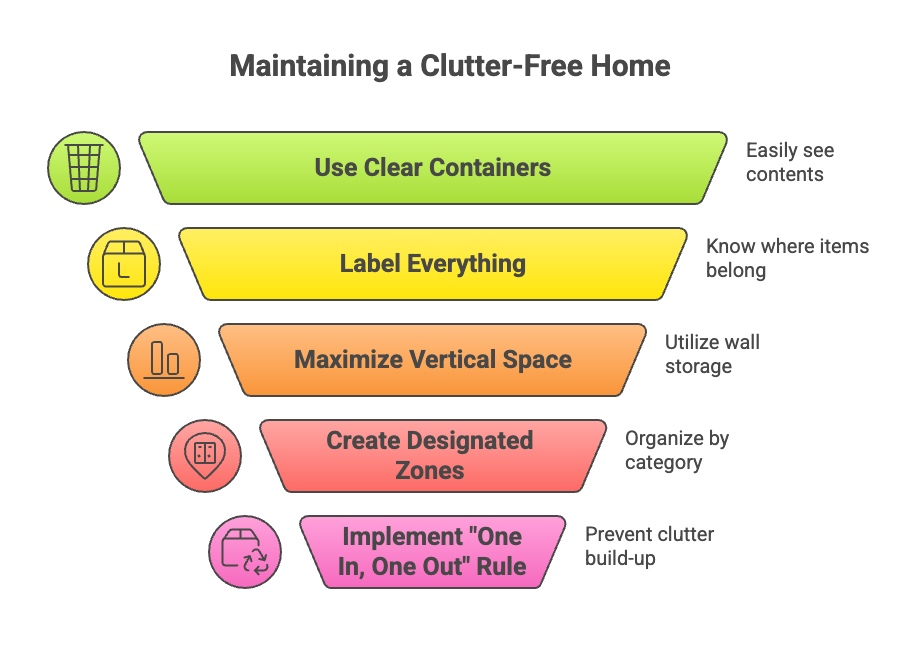Practical Decluttering Strategies for 3 Areas of Your Home
Decluttering strategies involve more than just tidying up; they involve creating a space that reflects one's intention, purpose, and joy.
For women over 55, the process of decluttering can be both empowering and liberating
Summary: This article gives women aged 55+ a practical, step-by-step approach to decluttering so their home becomes a clearer, lighter space that supports their next chapter. The focus is on simple strategies: beginning with smaller zones, using “keep/donate/toss” systems, handling sentimental items with care, and maintaining momentum. The underlying message: decluttering isn’t about loss—it’s about creating freedom, clarity and inviting the life you choose.
A Preamble
Decluttering is more than just tidying up; it’s about creating a space that reflects your intention, purpose, and joy.
For women 55+, using decluttering strategies can be both empowering and liberating.
It allows you to let go of what no longer serves you and make room for what truly matters.
This blog explores practical decluttering strategies, focusing on specific areas of your home, handling sentimental items with care, and organizing your space for long-term success. Here are some decluttering tips for all areas of your home.
Blog by Chris: Discover Emotional Healing Through Decluttering
Digital Download By Chris: The Ultimate Decluttering Checklist Package
Digital Download By Chris: The Ultimate Guide to Intentional Living
Decluttering is more than just tidying up; it’s about creating a space that reflects your intention, purpose, and joy.
For women 55+, using decluttering strategies can be both empowering and liberating.
Room-by-Room Guide: Tips for Decluttering Specific Areas
Every room in your home serves a unique purpose, and decluttering each space requires a tailored approach. Let’s break down how to tackle some of the most clutter-prone areas in your home.
1. Kitchen:
The kitchen is often the heart of the home, but it can quickly become cluttered with unused gadgets, expired pantry items, and mismatched containers. Start by:
Clearing countertops: Remove any items that don’t belong there. Keep only essentials, like your coffee maker or a fruit bowl.
Sorting through cabinets: Donate or discard duplicates, outdated food, and appliances you rarely use.
Organizing drawers: Use drawer dividers for utensils and designate specific spots for cooking tools.
2. Bedroom:
Your bedroom should be a sanctuary, but clutter can disrupt its calming atmosphere. To restore peace:
Streamline your wardrobe: Remove clothes that no longer fit, are out of style, or haven’t been worn in over a year. Consider donating gently used items.
Declutter nightstands: Keep only essentials —such as a lamp, book, or alarm clock —on your nightstand. Store or remove the rest.
Simplify bedding: Opt for a few quality sheets and comforters instead of excess linens.
3. Garage:
The garage often becomes a dumping ground for items without a designated spot. It may be time to organize the garage. Clear it out by:
Categorizing items: Group similar items together—tools in one area, sports equipment in another, and seasonal decorations in another.
Creating zones: Designate specific areas for storage, work, and parking. Install shelves or pegboards to keep things off the floor.
Disposing of unused items: Donate, sell, or recycle items that haven’t been used in the past year.
Every room in your home serves a unique purpose, and decluttering each space requires a tailored approach.
Let’s break down how to tackle some of the most clutter-prone areas in your home.
Decluttering Sentimental Items: How to Approach Items with Emotional Significance Thoughtfully
Sentimental items often carry deep emotional attachments, making them some of the most challenging things to declutter. However, holding onto too many of these items can lead to clutter that weighs you down. Here’s how to approach sentimental decluttering with care and thoughtful decluttering:
Reflect on the item’s significance: Ask yourself why you’re holding onto the item and what it represents. Is it the memory or the item itself that’s important to you?
Take photos: If the item has sentimental value but no practical use, consider taking a picture to preserve the memory without keeping the physical object.
Keep the best, let go of the rest: If you have multiple items tied to the same memory, choose the one that holds the most significance and let the others go.
Create a memory box: Designate a small box for sentimental items you want to keep. This helps you limit the space these items take while still honouring their importance.
Sentimental items often carry deep emotional attachments, making them some of the most challenging things to declutter
However, holding onto too many of these items can lead to clutter that weighs you down. Here’s how to approach sentimental decluttering with care and thoughtful decluttering:
Organizing Tips: Practical Advice on Storage Solutions and Organization After Decluttering
After decluttering, it’s essential to implement effective storage solutions to maintain a clutter-free home. Here are some practical decluttering and organizing tips:
Use clear containers: Transparent bins make it easy to see what’s inside, reducing the need to rummage through boxes and creating a more organized look.
Label everything: Labels help you and others know where things belong, making it easier to maintain order.
Maximize vertical space: Use wall-mounted shelves, hooks, or pegboards to keep items off the floor and make better use of vertical space.
Create designated zones: Assign specific areas for different categories of pantry items. For example, create zones for snacks, baking supplies, and canned goods.
Implement the “one in, one out” rule: For every new item you bring into your home, commit to removing an old one. This helps prevent future clutter build-up.
After decluttering, it’s essential to implement effective storage solutions to maintain a clutter-free home.
Implement the “one in, one out” rule: For every new item you bring into your home, commit to removing an old one. This helps prevent future clutter build-up.
Conclusion: Empower Your Life Through Helpful Decluttering Strategies
Decluttering is more than just a physical act—it’s a powerful way to enhance your emotional and psychological well-being.
Following these practical strategies, you can clear your home of unnecessary items, thoughtfully handle sentimental belongings, and organize your space for a clutter-free life.
As a woman 55 and older, embracing these practices will help you live with greater intention, purpose, passion, and joy.
From YouTube - WISE ELDER'S INSIGHT: 12 Things Older Women Keep Organizing - But Should Declutter Instead!
From YouTube - Elegance At 60: PART 2: Elegant Decluttering for Women | Wardrobe Decluttering for Women Over 50!
Ready to start your decluttering journey? Please share this post with others who might benefit, explore our related content for more tips in the section below, or download our Decluttering Checklist Package to kickstart your transformation today!
A Challenge For You:
Use the link above to download the decluttering checklist package. Also, read the blogs provided in the links because it is essential to understand your ‘whys’ before embarking on your decluttering project.
Gather the supplies and materials to clean successfully, purge and organize.
Embark on your decluttering project with purpose and passion, and know that you will feel joy and freedom at the end.
Celebrate your victories.
You are amazing!
FAQ
Q: Who is this article for?
A: Women aged 55+ who want to clear physical and mental space and feel more aligned with their home, life and values.
Q: What kind of decluttering techniques will I find?
A: Techniques like sorting items into categories (keep, donate, toss), starting one drawer or zone at a time, dealing sensitively with sentimental items, and creating maintainable routines rather than one big clean-up.
Q: Do I need to clear out everything in one go?
A: No. The article emphasizes gradual, realistic progress—one room, one drawer, one decision at a time—to avoid overwhelm and build positive momentum.
Q: What benefits can I expect from decluttering?
A: You’ll likely experience fewer distractions, less stress, more usable space, more clarity about what truly matters, and greater alignment between your environment and how you want to live.
Q: Is this a substitute for professional organizing or therapy?
A: No. These are practical lifestyle tools tailored for women 55+. If you’re handling major life transitions, severe emotional attachment to items, or complex health/mobility issues, professional support may still be appropriate.
👉 I thoughtfully use AI tools to polish my writing, but every story comes from my lived experience.




















